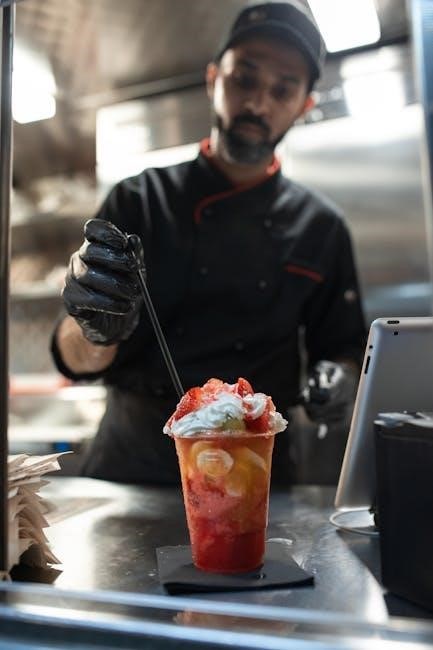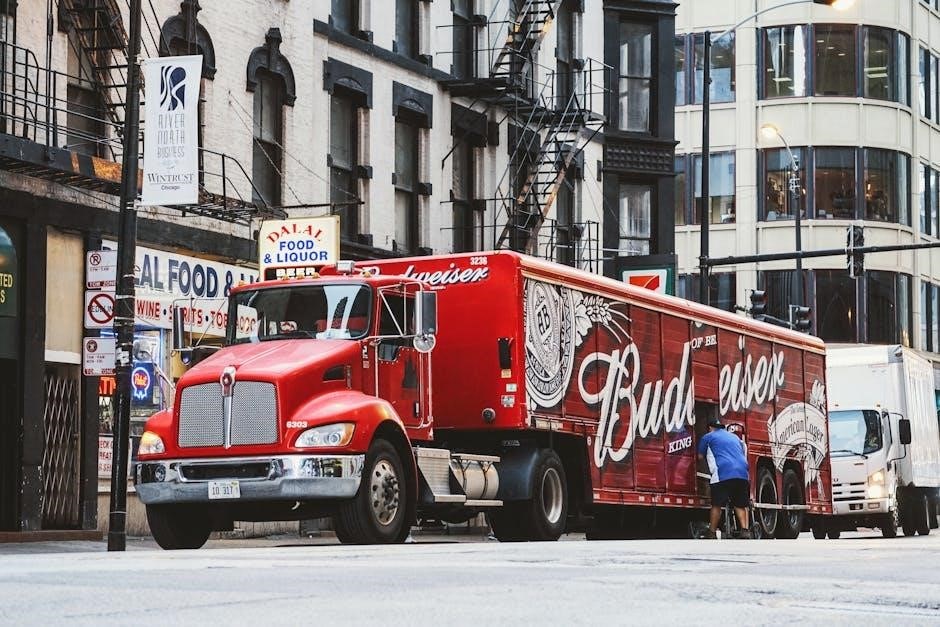
Executive Summary
The food truck business plan outlines the vision, goals, and strategies for a successful mobile food venture. It details target markets, menu offerings, operational plans, and financial projections to ensure profitability and sustainability.
1.1 Overview of the Food Truck Business
The food truck business is a dynamic and growing industry, offering mobility and flexibility in serving diverse cuisines to various locations. It involves operating a vehicle equipped with cooking facilities, targeting high-traffic areas like festivals, events, and urban centers. A well-structured business plan is essential, detailing operational strategies, menu offerings, and financial projections. This model allows entrepreneurs to minimize startup costs while maximizing reach and customer engagement, making it a popular choice for culinary ventures.
1.2 Vision and Mission Statement
The vision is to become a leading food truck brand, renowned for quality, innovation, and customer satisfaction. The mission is to serve diverse, flavorful dishes using fresh ingredients, while fostering community connections and exceeding customer expectations. By focusing on sustainability and exceptional service, the business aims to create a loyal customer base and contribute positively to the local food culture.
1.3 Business Objectives
Key objectives include launching the food truck within six months, achieving a 20% monthly profit margin, and capturing 10% market share in the first year. The business aims to offer a diverse menu, source 80% of ingredients locally, and maintain a 95% customer satisfaction rate. Additionally, the plan focuses on building a strong brand presence through social media and community events, ensuring long-term growth and sustainability in the competitive food truck industry.

Company Description
The company operates a mobile food truck offering diverse, high-quality cuisine. It focuses on unique flavors, sustainable practices, and excellent customer service to build a loyal customer base.
2.1 Business Structure and Ownership
The food truck business operates as a limited liability company (LLC), offering liability protection and tax flexibility. Ownership is held by [Owner’s Name], who oversees daily operations and strategic decisions. This structure allows for efficient management and scalability. The LLC model is ideal for food trucks, balancing personal asset protection with operational simplicity. Clear ownership definition aids in securing funding, managing permits, and ensuring compliance with legal requirements. This structure supports long-term growth and adaptability in a competitive market.
2.2 Core Offerings and Services
The food truck specializes in serving high-quality, diverse street food, including signature dishes, seasonal specials, and customizable options. The menu emphasizes locally sourced ingredients, catering to health-conscious and flavor-seeking customers. Services include on-site catering for events, festivals, and corporate functions, enhancing revenue streams. The truck also offers online ordering and delivery partnerships, expanding accessibility. This diverse approach ensures a wide customer appeal and consistent demand, positioning the business as a versatile and reliable food service provider in the market.
2.3 Location and Operational Area
The food truck will operate in high-traffic areas such as downtown districts, event venues, and popular landmarks to maximize visibility and customer access. Strategic locations will be selected based on foot traffic, competition, and local regulations. The truck will also participate in festivals, concerts, and corporate events to expand its reach. Permits and licenses will be obtained to ensure compliance with local health and safety standards, enabling smooth operations across the target area.

Market Analysis
The food truck industry is growing, driven by demand for convenient, unique dining experiences. Targeting busy professionals, students, and event-goers, the business will capitalize on this trend effectively.
3.1 Food Truck Industry Overview
The food truck industry has experienced significant growth, driven by increasing consumer demand for convenient and diverse dining options. With an estimated global market size of over $4 billion, the sector is expected to continue expanding, supported by urbanization and the popularity of street food. Key trends include the rise of niche cuisines, technological advancements in operations, and the importance of sustainability. This growth presents a lucrative opportunity for new entrants to establish successful food truck businesses.
3.2 Target Market and Customer Segmentation
The target market for a food truck business includes urban professionals, students, and event-goers seeking affordable, quick, and high-quality meals. Customer segmentation focuses on demographics like age, location, and preferences, such as health-conscious individuals or fans of specific cuisines. By identifying these groups, the business can tailor menu offerings and marketing strategies to meet their needs effectively, ensuring strong customer engagement and loyalty in a competitive market.
3.3 Competitive Analysis
A competitive analysis identifies key food truck competitors, evaluating their strengths, weaknesses, and market strategies. This includes menu offerings, pricing, branding, and operational efficiency. By understanding the competition, the business can differentiate itself through unique menu specialties, superior customer service, or strategic location choices. This analysis also reveals market gaps, enabling the business to capitalize on unmet customer needs and establish a strong foothold in the industry.
3.4 Industry Trends and Statistics
The food truck industry is growing rapidly, with projected revenues reaching $6.6 billion by 2030. Key trends include the rise of niche markets, such as gourmet and specialty foods, and increasing demand for healthy and ethnic cuisine. Mobile ordering and payment options are also enhancing customer convenience. Statistics show that 70% of consumers prefer food trucks for quick, affordable meals, while 60% of operators emphasize sustainability and locally sourced ingredients. These trends highlight opportunities for differentiation and growth in the market.
Menu and Pricing Strategy
The menu features specialty dishes, including gourmet and ethnic options, priced competitively to attract diverse customers. Sourcing high-quality ingredients ensures flavor and freshness, supporting revenue goals and customer satisfaction.
4.1 Menu Offerings and Specialties
The menu offers a diverse range of specialty dishes, including gourmet burgers, ethnic cuisine, and vegan options, catering to various dietary preferences. Signature items like loaded fries and unique sauces differentiate the brand, attracting a loyal customer base. Seasonal specials and limited-time offers keep the menu fresh and exciting, ensuring repeat business and positive word-of-mouth. High-quality ingredients are sourced locally to maintain flavor and freshness, aligning with customer expectations for quality and sustainability.
4.2 Pricing Strategy and Revenue Model
The pricing strategy is competitive, with menu items ranging from $8 to $12, ensuring affordability while maintaining quality. Tiered pricing and discounts for bulk orders attract diverse customer segments. Revenue is generated through daily sales, event bookings, and catering services. A profit margin of 25-30% is projected, with adjustments based on location and demand. The model emphasizes cashless payments and digital ordering to streamline operations and increase efficiency, ensuring sustainable financial growth and customer satisfaction.
4.3 Sourcing of Ingredients and Supplies

Sourcing high-quality ingredients is crucial for maintaining menu standards. Local farmers and sustainable suppliers are prioritized to ensure freshness and reduce costs. Relationships with reliable distributors guarantee consistent availability of essential supplies. Cost-effective procurement strategies are implemented to balance quality and affordability. Regular audits ensure compliance with health and safety regulations. This approach supports menu appeal, pricing strategy, and operational efficiency while promoting environmental responsibility and community support.

Operational Plan
The operational plan outlines strategies for efficient food truck management, ensuring smooth day-to-day operations, and maintaining high service standards to meet customer demand effectively.
5.1 Location Selection and Permitting
Strategic location selection is vital for a food truck’s success, focusing on high-traffic areas like festivals, downtown districts, and event venues. Ensure compliance with local regulations, obtaining necessary permits and licenses; Conduct site visits to assess visibility, accessibility, and competition. Secure permits from health departments, fire safety, and business licensing agencies. Understand zoning laws and parking restrictions to avoid operational disruptions. Proper permitting ensures legal operation, protecting your business and reputation.

5.2 Equipment and Vehicle Requirements
A food truck requires specialized equipment and a suitable vehicle to operate efficiently. Essential equipment includes commercial-grade appliances like refrigerators, grills, fryers, and point-of-sale systems. The vehicle must be customized to accommodate kitchen operations, ensuring proper ventilation and electrical setups. Health and safety standards must be met, with equipment meeting local regulations. Budgeting for the truck’s purchase or lease, along with equipment costs, is critical. Properly equipping the truck ensures smooth operations and compliance with health codes.
5.3 Staffing and Training
Staffing a food truck requires hiring skilled and reliable individuals, including chefs, cashiers, and managers. Training is essential to ensure consistency in food quality and customer service. Employees should be trained in food safety, equipment operation, and customer interaction. Ongoing training programs help maintain high standards and adapt to new menu items or operational changes. Clear communication and teamwork are vital for efficient service during busy periods. Investing in staff training enhances customer satisfaction and supports long-term business success.
5.4 Day-to-Day Operations and Logistics
Day-to-day operations involve managing schedules, locations, and inventory efficiently. The food truck must maintain a consistent daily schedule, ensuring timely arrival at high-traffic areas. Inventory management is critical to avoid shortages or excess, while waste disposal must comply with health regulations. Logistics include coordinating supply chains for fresh ingredients and maintaining equipment functionality. Regular cleaning and adherence to health standards are non-negotiable. Effective logistics ensure smooth operations, enabling the food truck to deliver quality service and maintain customer satisfaction consistently.
Marketing and Sales Strategy
A successful food truck business relies on effective branding, social media engagement, and targeted promotions. Utilize local events, discounts, and loyalty programs to attract and retain customers, ensuring consistent sales growth.
6.1 Branding and Marketing Plan
A strong brand identity is crucial for a food truck business. Develop a unique logo, name, and tagline that reflect the brand’s personality. Use social media platforms like Instagram and Facebook to showcase menu items and interact with customers. Implement email marketing campaigns to share updates and promotions. Partner with local influencers to increase visibility. Create a loyalty program to reward repeat customers and encourage word-of-mouth referrals. Consistent branding across all channels builds trust and attracts a loyal customer base.
6.2 Sales Channels and Customer Acquisition
Effective sales channels include social media, email marketing, and partnerships with local influencers. Utilize Instagram and Facebook to showcase menu items and engage with customers. Offer online ordering through the website or third-party apps like Uber Eats. Host pop-up events and catering services to expand reach. Implement loyalty programs to reward repeat customers and encourage referrals. Use targeted ads to attract specific demographics. Collaborate with local businesses to create cross-promotional opportunities, ensuring consistent customer flow and brand visibility.
6.3 Promotional Tactics and Events
Implement social media campaigns to engage customers and promote specials. Offer limited-time discounts and themed days to drive sales. Host live events, such as cooking demos or giveaways, to attract crowds. Partner with local breweries or festivals for increased visibility. Use email marketing to share exclusive offers and updates. Create loyalty programs to reward repeat customers. Collaborate with influencers for sponsored content. Ensure consistent branding across all platforms to build recognition and trust. These tactics will help build a loyal customer base and boost brand visibility effectively.
Financial Plan
The financial plan outlines startup costs, revenue projections, and funding requirements. It includes detailed financial metrics, break-even analysis, and strategies for achieving profitability and long-term sustainability.

7.1 Startup Costs and Funding Requirements
Startup costs for a food truck business include purchasing a truck, kitchen equipment, permits, insurance, and initial branding. Funding requirements may involve loans, investors, or personal savings. A detailed financial plan is essential to outline these expenses and secure investments. Proper budgeting ensures all initial costs are covered, allowing the business to operate smoothly from launch. Accurate financial projections help attract investors and demonstrate the viability of the business model.

7.2 Revenue Projections and Profitability
Revenue projections outline the expected income based on sales volume, pricing, and market conditions. Achieving profitability requires efficient cost management and maximizing menu sales. A break-even analysis is crucial to determine when the business will cover its expenses. Accurate financial forecasting ensures sustainability and growth, attracting investors and guiding operational decisions effectively.
7.3 Break-Even Analysis and Financial Metrics
A break-even analysis calculates the point where revenue equals total costs, ensuring profitability. Key financial metrics include net profit margin, return on investment, and cash flow projections. By analyzing fixed and variable costs, the business can determine the required sales volume to break even. This analysis helps identify financial health, optimize pricing, and make informed decisions to achieve long-term profitability and sustainability in the competitive food truck industry.
Case Studies and Examples
Successful food truck businesses demonstrate effective strategies, such as Kogi BBQ, which revolutionized the industry with fusion cuisine and social media marketing, offering valuable lessons for entrepreneurs.
8.1 Successful Food Truck Business Models
Examples like Kogi BBQ and The Grilled Cheese Truck showcase thriving food truck models. Kogi BBQ pioneered fusion cuisine, leveraging social media for viral success. The Grilled Cheese Truck offers gourmet twists on classics, while Taco Trek focuses on authentic flavors. These models highlight niche targeting, quality ingredients, and strong branding. They demonstrate how a clear vision, efficient operations, and customer engagement drive long-term success in the competitive food truck industry.
8.2 Lessons Learned from Industry Leaders
Industry leaders emphasize the importance of a unique value proposition, adaptability, and strong branding. Successful food truck businesses focus on quality ingredients, efficient operations, and customer engagement. They highlight the need for thorough market research, financial planning, and compliance with regulations. Leveraging technology, such as POS systems and social media, is crucial for growth. These insights underscore the importance of resilience, innovation, and strategic planning to thrive in the competitive food truck industry.
Business Plan Templates and Tools
Utilize free food truck business plan PDF templates and software tools to streamline your planning process. These resources offer professional layouts, financial projections, and step-by-step guidance for success.
9.1 Free Food Truck Business Plan PDF Templates
Download free food truck business plan PDF templates to streamline your planning process. These templates, available from platforms like PlanPros.ai and Growthink, offer professional layouts and step-by-step guidance. They include sections for executive summaries, market analysis, financial projections, and operational strategies. Customize them to fit your business needs, ensuring a solid foundation for your food truck venture. These templates are designed to save time and provide a clear roadmap for success in the competitive food truck industry.
9.2 Software and Resources for Creating a Business Plan
Utilize software like PlanPros.ai and Growthink to create a professional food truck business plan. These tools offer advanced features such as automated financial statements, customizable templates, and step-by-step guidance. They provide pre-designed layouts and AI-driven insights to streamline the planning process. Additionally, resources like IMARC Groups’ detailed project reports and editable Word templates can help you craft a comprehensive and investment-ready business plan tailored to your food truck venture.

Legal and Regulatory Requirements
Obtain necessary licenses, permits, and comply with health codes. Secure insurance coverage to protect against liability and operational risks, ensuring legal compliance for your food truck business.
10.1 Licenses and Permits Needed
To operate a food truck, you must obtain a food service license, business operation permit, and health department certification. Additional requirements include fire safety permits, local business registration, and food handler certifications. Ensure compliance with all state and local regulations to avoid penalties. These documents validate your business legitimacy and ensure public safety. Research specific requirements in your operational area to secure necessary approvals before launching your food truck venture.
10.2 Health and Safety Regulations
Adhering to health and safety regulations is crucial for a food truck business. Proper food handling, storage, and waste disposal practices must be implemented. Regular inspections and staff training ensure compliance with local health codes. Maintaining a clean environment and using food-safe equipment are essential. These practices protect public health and build customer trust, ensuring the longevity of your food truck venture.
10.4 Insurance and Liability Coverage
Obtaining adequate insurance and liability coverage is essential for a food truck business. General liability insurance protects against customer injuries or property damage. Commercial auto insurance covers the truck and its operations. Equipment insurance safeguards against theft or damage to kitchen gear. Workers’ compensation insurance is necessary if you hire staff. These coverages ensure financial protection and compliance with legal requirements, minimizing risks and securing your business against unforeseen events.
Risk Management and Contingency Planning
A food truck business plan must identify potential risks such as bad weather, equipment failure, or regulatory changes. Develop contingency strategies like backup locations, emergency funds, and flexible scheduling to ensure continuous operations and minimize financial losses.
11.1 Identifying Potential Risks
Identifying potential risks in a food truck business plan involves addressing market saturation, regulatory compliance, and operational challenges. Key risks include unpredictable weather, equipment breakdowns, and supply chain disruptions. Additionally, health inspections, parking restrictions, and economic downturns can impact profitability. A thorough risk assessment ensures the business is prepared for unforeseen events, such as liability issues or staff shortages. By understanding these risks, entrepreneurs can develop strategies to mitigate their impact and ensure long-term sustainability. This step is crucial for building resilience in a competitive market.
11.2 Strategies for Mitigating Risks
Strategies for mitigating risks in a food truck business include diversifying menu offerings to attract a broader customer base and securing multiple operating locations to reduce dependency on a single site. Regular maintenance of equipment and contingency plans for unexpected breakdowns are essential. Building strong relationships with suppliers ensures consistent ingredient availability. Additionally, maintaining compliance with health and safety regulations and investing in liability insurance can protect against legal and financial risks. A well-prepared risk mitigation plan enhances operational resilience and long-term success.
The food truck business plan provides a clear roadmap for success. Next steps include finalizing the plan, securing funding, and launching operations to achieve long-term growth and profitability.
12.1 Summary of Key Points
A successful food truck business plan outlines the vision, target market, menu offerings, operational strategies, and financial projections. It ensures clarity and direction for entrepreneurs to achieve sustainability and growth.
The plan must address industry trends, competitive analysis, and regulatory requirements. By focusing on these elements, entrepreneurs can create a comprehensive roadmap to launch and scale their food truck venture effectively.
12.2 Action Plan for Implementation
Secure funding and finalize permits. Purchase or lease a food truck and necessary equipment. Develop a menu and source high-quality ingredients. Hire and train staff. Create a marketing strategy and establish sales channels. Launch operations in targeted locations. Monitor financial performance and adjust strategies as needed. Continuously evaluate customer feedback to improve offerings and services. Expand operations based on profitability and market demand.